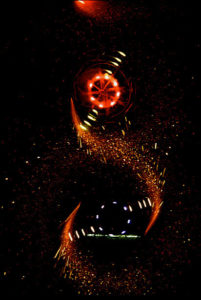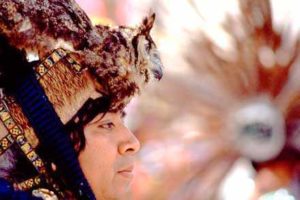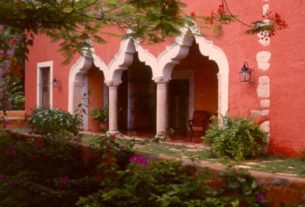The Calendario de las Ferias y Festividades Religiosas de Mexico is a guide to enjoying what is uniquely Mexican — Folk Catholicism which evolved in the last four centuries. Fairs are included in the same calendar because during longer religious festivities, artisans and vendors from other pueblos set up puestos to sell their wares. Fairs of a secular nature, such as the Peach Fair, appear in the Festivals & National Holidays for Mexico.
During the Colonial Period, Franciscan and Jesuit friars charged with indoctrinating indigenous people encouraged dances, pageants and the wearing of costumes and masks as a way of dramatizing Biblical stories.
The 16th century version of Spanish Roman Catholicism embraced many rituals, as did the old religions of the Maya, the Purépecha and the Aztec tribes. So the adaptation was less painful for the Indians of Mexico than in other countries in the same hemisphere, where conversion was accompanied with much bloodshed.
The visitor to Mexico has only to observe what happens in any pueblo: women scurrying to Mass at dawn, wrapped in rebozos and sweaters, or the special Sunday celebration of First Communion in which small Daughters of Christ, aged 9 or 10, wear long satin dresses. Or one may note that the Virgin of Guadalupe protects the bus passengers, her decal or picture on the window. Or oddest of all, a tattoo of the Virgin on the brawny arm of a soldier. Observing these things we know, yes, undoubtedly Mexico is Catholic.
Faith is at the heart of most fiestas.
 Firecrackers, fireworks and gunpowder explosions are an integral part of Mexican fiestas. They announce and enhance events of the celebration, often beginning before dawn. Gun powder explodes inside a metal tube firmly placed in the ground, and the sound reverberates like heavy artillery. Some care is taken to avoid accidents, but Mexico City is the only area where gun powder and firecrackers are prohibited. As fiesta aficionados well know, the crowning fireworks are torched on the last day of the fiesta and often on the weekends as well. Castillos are towers of fireworks intricately fashioned so that they turn, shoot into the air and create designs one portion at a time. Usually they are shot at 10:00 or 11:00 at night and daring muchachos stand close enough to prove their valor and singe their clothes with sparks.
Firecrackers, fireworks and gunpowder explosions are an integral part of Mexican fiestas. They announce and enhance events of the celebration, often beginning before dawn. Gun powder explodes inside a metal tube firmly placed in the ground, and the sound reverberates like heavy artillery. Some care is taken to avoid accidents, but Mexico City is the only area where gun powder and firecrackers are prohibited. As fiesta aficionados well know, the crowning fireworks are torched on the last day of the fiesta and often on the weekends as well. Castillos are towers of fireworks intricately fashioned so that they turn, shoot into the air and create designs one portion at a time. Usually they are shot at 10:00 or 11:00 at night and daring muchachos stand close enough to prove their valor and singe their clothes with sparks.
El Torito de Luz may run through the plaza taunting the crowd and creating another opportunity for the young to show their bravery (or foolishness.) He is a person wearing a bull’s head of papier mache or mimbre (a kind of plant fiber) from which little sparkling fireworks are shot off. He often precedes the performance of ritual dances.
These, the danzas are a uniquely Mexcican aspect of some fiestas and they are listed in the calendar as danzas, not bailes, which are social dances. Ritual dances are distinct from folkloric dances which are called balet folklorico. It is always a good idea to inquire in the neighboring pueblo or to make a visit to the small pueblo where the danzantes have performed before in order to verify that it will indeed occur again. Like all ancient customs in the Republic, these are variable.
Perhaps the most frequently filmed spectacle is the Dance of the Voladores, well known in Papantla, Vera Cruz and performed at the fiesta of Corpus Cristi. Not only in Vera Cruz, but north through Tlaxcala, Hidalgo and on to San Luis Potosi, the flyers perform a death defying rite, diving from a pole, their feet held by ropes. Shortly after the Conquest the dance was performed by men dressed as bright birds, macaws and eagles, so we learn from the writings of an Indian scribe writing in Spanish.The voladores dressed as eagles and macaws and flew from a pole so tall it was possible to make 13 revolutions before they landed. This represented eras of 52 years, divided into epochs of 13 years each
Among the Otomís, Huastecas, Totonacas and descendants of the Aztecs, the number of fliers and type of costume is variable. Some carry musical instruments as do the Otomí of Pahuantlán, Vera Cruz. The young man who takes the part of la Malinche not only dresses as a woman and dances on a 24 inch platform, but leans forward to embrace the other dancers with a large bandana.
In each place the choice of the tree is an important task and it is cut to form the pole from which the dancers will fly and given offerings of wine, bread, and incense to insure a safe performance.
Another group of dancers, the Concheros are a large and dedicated group numbering perhaps 30,000 to 40, 000 members They live in the Federal District, Tlaxcala, Hidalgo, Guanajuato and sometimes in Jalisco. Their name, the people of the shell, comes from the mandolin which accompanies them, fashioned from the shell of an armadillo. They consider themselves soldiers of the Conquest, and may call themselves Apaches or more accurately, Chichimecas, the name of the tribe which invented the dance shortly after the fall of Tenochititlán. These Indians wore their hair long, and the male dancers of today do so as well.

All dancers, men and women, wear elaborate feathered head dresses, some with tall ostrich plumes. Their costumes are opulent, trimmed with gold braid and glass beads. The men may elect to wear simply a satin cape, and head dress and a loin cloth. On the cape is embroidered some part of the design which is on the banner, immortalizing the date of founding of the group and its patron saint. The banner is held by two standard bearers at every dance and during processions. Standard bearers care for the banner when the group travels.
The organization of the group centers around a mesa or table which serves as an altar dedicated to a saint who protects the group. The second captain in the group is charged with caring for the altar; The captain makes strict rules regarding the conduct of the initiated and those who would like to join. The initiation ritual includes offerings of flowers, candles and the indispensable copal incense, gathered from trees by the faithful. Candles, especially large tapers, may be rented from the mayordomo of the pueblo who charges the people for the quantity burned.
Members of the mesa make a vow to help one another in family emergencies and during illnesses and must make up before a trip if they have quarreled. Sometimes trips take up to two weeks and unity among the members is vital. Worshiping the four winds or the four cardinal points, the Concheros consider that the most important shrines are those located north, south, east and west of Mexico City. These are La Villa de Guadalupe, Chalma, Los Remedios and Amecameca.
An old custom which is falling out of use is setting up a white cross, symbolizing the four winds and singing the songs known as albanzas all night before the day of the dances. The dance itself is usually performed in the atrium, not in the church proper. The movements consist of leaping and contracting the legs, of jumping into the air with both feet and landing on the toes. Afterwards dancers enter the church to bid adios to the saint being honored with a fiesta, singing albanzas and then dancing backward out of the church to avoid turning their backs on the altar.
Not all dances have a direct link to Christian saints and symbols. Yaqui pascolas or deer dances are performed at religious festivals, accompanied by musicians who play music with an irregular beat .The fiesta may or may not be dedicated to a saint. Three or four pascolas dance games (juegos) with the deer pretending to be coyotes who will kill him. The music becomes erratic, nervous. Finally they succeed, and shoulder his “carcass”, bringing it to the person who is in charge of the fiesta. This patron must purchase it with bottles of brandy or pulque for the dancers.
The pascolas may imitate tigers or buzzards or play a game of bewitching the deer, in which the deer is mesmerized but not killed. The dancer who portrays the deer wears a stuffed cloth deer head, sometimes with real antlers, and dried cocoons filled with gravel (ténabari) around his ankles. His torso is bare and deer claws hang from a belt around the waist. The Pascolas also dance bare chested , with tenabari around their ankles and they wear a small wooden mask on top of the head so their vision is not impaired.
Wherever one finds them, the danzas are an unforgettable vision of Mexico’s past. I am grateful for the information on ritual dances contained in Frances Toor’s book, “A Treasury of Mexican Folklore,” now out of print.

